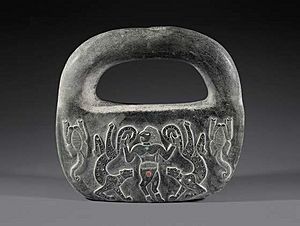Jiroft civilization facts for kids
The Jiroft culture is the name given to an ancient civilization that might have existed during the Bronze Age (around the late 3rd millennium BC). It was located in what is now Iran, specifically in the areas of Balochistan and Kerman Province.
This idea of a Jiroft culture came about because many old objects were found in the Jiroft area. These objects were first reported by Iranian news in 2001.
The main place where this culture is thought to have been is called Konar Sandal. It's located near Jiroft, by the Halil River. Other important places linked to this culture include Shahr-e Sukhteh (also known as Burnt City), Tepe Bampur, Espiedej, Shahdad, Tal-i-Iblis, and Tepe Yahya.
A person named Yusef Majidzadeh, who led the archaeological digs in Jiroft, believes this was a unique Bronze Age civilization. He thinks it had its own special buildings and language. He suggests it was located between Elam (to the west) and the Indus Valley civilization (to the east). Majidzadeh even thinks it might be the lost Kingdom of Aratta. However, some experts are not fully convinced by these ideas.
Discovering the Ancient Jiroft Culture
Many artifacts connected to the Jiroft culture were first found by people who were looking for valuable items before official digs began. These people were described as "poor villagers" who searched the area south of Jiroft before 2001.
In 2001, a team of archaeologists led by Yusef Majidzadeh started official excavations. They uncovered more than two square kilometers of an ancient city. This city dates back to at least the late 3rd millennium BC. The information gathered by Majidzadeh's team shows that Jiroft was most important between 2500 BC and 2200 BC.
The objects found by the looters, and some pots discovered by the archaeologists, had a special look. This style of pottery is known as "intercultural style." It has been found in places like Mesopotamia and other parts of Iran. It was also found at a nearby site called Tepe Yahya in Baft since the 1960s. The idea of a "Jiroft civilization" suggests that this "intercultural style" was actually the unique look of a previously unknown, long-lasting civilization.
Images for kids
See also
 In Spanish: Civilización de Jiroft para niños
In Spanish: Civilización de Jiroft para niños







